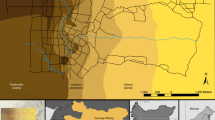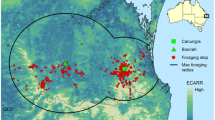Abstract
Context
Animal population dynamics are shaped by their movement decisions in response to spatial and temporal resource availability across landscapes. The sporadic availability and diversity of resources can create highly dynamic systems. This is especially true in agro-ecological landscapes where the dynamic interplay of insect movement and heterogeneous landscapes hampers prediction of their spatio-temporal dynamics and population size.
Objectives
We therefore systematically looked at population-level consequences of different movement strategies in temporally-dynamic resource landscapes for an insect species whose movement strategy is slightly understood: the Queensland Fruit Fly (Bactrocera tryoni)
Methods
We developed a spatially-explicit model to predict changes in population dynamics and sizes in response to varying resources across a landscape. We simulated the temporal dynamics of fruit trees as the main resource using empirical fruiting dates. Movement strategies were derived from general principles and varied in directedness of movement and movement trigger.
Results
We showed that temporal continuity in resource availability was the main contributing factor for large and persistent populations. This explicitly included presence of continuous low-density resources such as fruit trees in urban areas. Analysing trapping data from SE Australia supported this finding. We also found strong effects of movement strategies, with directed movement supporting higher population densities.
Conclusions
These results give insight into structuring processes of spatial population dynamics of Queensland Fruit Fly in realistic and complex food production landscapes, but can also be extended to other systems. Such mechanistic understanding will help to improve forecasting of spatio-temporal hotspots and bottlenecks and will, in the end, enable more targeted population management.




Similar content being viewed by others
References
Amarasekare P (2004) The role of density-dependent dispersal in source–sink dynamics. J Theor Biol 226(2):159–168
Balagawi S, Jackson K, Hamacek EL, Clarke AR (2012) Spatial and temporal foraging patterns of Queensland fruit fly, Bactrocera tryoni (Froggatt) (Diptera: Tephritidae), for protein and implications for management: Qfly foraging for protein in the field. Aust J Entomol 51(4):279–288
Bastille-Rousseau G, Gibbs JP, Yackulic CB, Frair JL, Cabrera F, Rousseau L-P, Wikelski M, Kümmeth F, Blake S (2017) Animal movement in the absence of predation: environmental drivers of movement strategies in a partial migration system. Oikos 126(7):1004–1019
Birch CPD, Oom SP, Beecham JA (2007) Rectangular and hexagonal grids used for observation, experiment and simulation in ecology. Ecol Model 206(3–4):347–359
Bonte D, Van Dyck H, Bullock JM, Coulon A, Delgado M, Gibbs M, Lehouck V, et al. (2012) Costs of dispersal. Biol Rev 87:290–312
Bourhis Y, Poggi S, Mammeri Y, Le Cointe R, Cortesero A-M, Parisey N (2017) Foraging as the landscape grip for population dynamics: a mechanistic model applied to crop protection. Ecol Model 354(June):26–36
Bowler DE, Benton TG (2005) Causes and consequences of animal dispersal strategies: relating individual behaviour to spatial dynamics. Biol Rev Camb Philos Soc 80(2):205–225
Clarke AR, Powell KS, Weldon CW, Taylor PW (2011) The ecology of Bactrocera tryoni (Diptera: Tephritidae): what do we know to assist pest management? Ann Appl Biol 158(1):26–54
Dermo RF, Peterson MA (1995) Density-dependent dispersal and its consequences for population dynamics. In: Cappuccino N, Price PW (eds) Population dynamics. Academic Press, San Diego, pp 113–130
Dominiak BC (2012) Review of dispersal, survival, and establishment of Bactrocera tryoni (Diptera: Tephritidae) for quarantine purposes. Ann Entomol Soc Am 105(3):434–446
Economopoulos AP, Rempoulakis P (2018) Back-yard medfly is a key factor in area-wide management in Southern Europe. data from Attiki Greece, 38ο northern latitude. Entomol Hellenica 26(II):29–36
Fahrig L (2003) Effects of habitat fragmentation on biodiversity. Annu Rev Ecol Evol Syst 34:487–515
Fahrig L (2017) Ecological responses to habitat fragmentation per se. Annu Rev Ecol Evol Syst 48:1–23
Fahrig L, Baudry J, Brotons L, Brotons L, Burel FG, Crist TO, Fuller RJ, Sirami C, Siriwardena GM, Martin J-L (2011) Functional landscape heterogeneity and animal biodiversity in agricultural landscapes. Ecol Lett 14(2):101–112
Fahrig L, Merriam G (1985) Habitat patch connectivity and population survival. Ecology 66(6):1762–1768
Fahrig L, Triantis K (2013) Rethinking patch size and isolation effects: the habitat amount hypothesis. J Biogeogr 40(9):1649–1663
Fanson BG, Taylor PW (2012) Additive and interactive effects of nutrient classes on longevity, reproduction, and diet consumption in the queensland fruit fly (Bactrocera Tryoni). J Ins Physiol 58(3):327–334
Fanson BG, Weldon CW, Pérez-Staples D, Simpson SJ, Taylor PW (2009) Nutrients, not caloric restriction, extend lifespan in Queensland fruit flies (Bactrocera tryoni). Aging Cell 8(5):514–523
Farnsworth KD, Beecham JA (1999) How do grazers achieve their distribution? A continuum of models from random diffusion to the ideal free distribution using biased random walks. Am Nat 153(5):509–526
Fernández N, Román J, Delibes M (2016) Variability in primary productivity determines metapopulation dynamics. Proc R Soc B 283(1828):20152998
Fitt GP (1984) Oviposition behaviour of two tephritid fruit flies, Dacus Tryoni and Dacus Jarvisi, as influenced by the presence of larvae in the host fruit. Oecologia 62(1):37–46
Fletcher BS (1974) The ecology of a natural population of the queensland fruit fly, Dacus Tryoni. Vi. Seasonal changes in fruit fly numbers in the areas surrounding the orchard. Aust J Zool 22(3):353–363
Getz WM, Saltz D (2008) A framework for generating and analyzing movement paths on ecological landscapes. PNAS 105(49):19066–19071
Gough B (2009) GNU scientific library reference manual, 3rd edn. Network Theory Ltd, Massachusetts
Grant TJ, Parry HR, Zalucki MP, Bradbury SP (2018) Predicting monarch butterfly (Danaus plexippus) movement and egg-laying with a spatially-explicit agent-based model: The role of monarch perceptual range and spatial memory. Ecol Model 374(April):37–50
Hancock DL, Queensland, Department of Primary Industries (1999) The distribution and host plants of fruit flies (Diptera Tephritidae) in Australia. Dept. of Primary Industries, Brisbane
Hanski I (1998) Metapopulation dynamics. Nature 396(6706):41–49
Hanski I (2015) Habitat fragmentation and species richness. J Biogeogr 42(5):989–993
Harris A (2009) Can the Queensland fruit fly larval parasitoid Diachasmimorpha kraussii (Fullaway) (Hymenoptera: Braconidae) be reared on irradiated larval hosts? MSc Thesis, Imperial College London
Kromp B, Steinberger K-H (1992) Grassy field margins and arthropod diversity: a case study on ground beetles and spiders in eastern Austria (Coleoptera: Carabidae; Arachnida: Aranei, Opiliones). Agric Ecosyst Environ 40:71–93
Leibold MA, Holyoak M, Mouquet N, Amarasekare P, Chase JM, Hoopes MF, Holt RD, et al. (2004) The metacommunity concept: a framework for multi-scale community ecology. Ecol Lett 7(7):601–613
Lloyd AC, Hamacek EL, Smith D, Kopittke RA, Gu H (2013) Host susceptibility of citrus cultivars to queensland fruit fly (Diptera: Tephritidae). J Econ Entomol 106(2):883–890
Matthysen E (2005) Density-dependent dispersal in birds and mammals. Ecography 28(3):403–416
Merkel K, Florian S, Andrew DH, Nancy S, David W, Clarke AR (2019) Temperature effects on ‘Overwintering’ phenology of a polyphagous, tropical fruit fly (Tephritidae) at the subtropical/temperate interface. J Appl Entomol 143(7):754–765
Mueller T, Fagan WF (2008) Search and navigation in dynamic environments: from individual behaviors to population distributions. Oikos 117(5):654–664
Mueller T, Olson KA, Dressler G, Leimgruber P, Fuller TK, Nicolson C, Novaro AJ, et al. (2011) How landscape dynamics link individual- to population-level movement patterns: a multispecies comparison of ungulate relocation data. Glob Ecol Biogeogr 20(5):683–694
Nathan R, Getz WM, Revilla E, Holyoak M, Kadmon R, Saltz D, Smouse PE (2008) A movement ecology paradigm for unifying organismal movement research. PNAS 105(149):19052–19059
O’loughlin GT, East RA, Meats A (1984) Survival, development rates and generation times of the Queensland fruit fly, Dacus Tryoni, in a marginally favourable climate: experiments in Victoria. Aust J Zool 32(3):353–361
Parry HR, Paull CA, Zalucki MP, Ives AR, Hulthen A, Schellhorn NA (2017) Estimating the landscape distribution of eggs by Helicoverpa spp., with implications for Bt resistance management. Ecol Model 365(December):129–140
Pritchard G (1970) The ecology of a natural population of Queensland fruit fly, Dacus tryoni III. The maturation of female flies in relation to temperature. Aust J Zool 18(1):77
Pulliam HR, Danielson BJ (1991) Sources, sinks, and habitat selection: a landscape perspective on population dynamics. Am Nat 137(June):S50–S66
Revilla E, Wiegand T (2008) Individual movement behavior, matrix heterogeneity, and the dynamics of spatially structured populations. PNAS 105(49):19120–19125
Reynolds Ol, Orchard Ba (2011) Effect of adult chill treatments on recovery, longevity and flight ability of queensland fruitfFly, Bactrocera Tryoni (Froggatt) (Diptera: Tephritidae). Bull Entomol Res 101(01):63–71
Schellhorn NA, Bianchi FJJA, Hsu CL (2014) Movement of entomophagous arthropods in agricultural landscapes: links to pest suppression. Annu Rev Entomol 5(1)9:559–581.
Schellhorn NA, Gagic V, Bommarco R (2015) Time will tell: resource continuity bolsters ecosystem services. Trends Ecol Evol 30(9):524–530.
Sultana S, Baumgartner JB, Dominiak BC, Royer JE, Beaumont LJ (2017) Potential impacts of climate change on habitat suitability for the Queensland fruit fly. Sci Rep. https://doi.org/10.1038/s41598-017-13307-1
Sutherst RW, Yonow T (1998) The geographical distribution of the Queensland fruit fly, Bactrocera (Dacus) tryoni, in relation to climate. Aust J Agric Res 49(6):935–954
Teitelbaum CS, Fagan WF, Fleming CH, Dressler G, Calabrese JM, Leimgruber P, Mueller T (2015) How far to go? Determinants of migration distance in land mammals. Ecol Lett 18(6):545–552.
Thierry H, Vialatte A, Choisis J-P, Gaudou B, Parry H, Monteil C (2017) Simulating spatially-explicit crop dynamics of agricultural landscapes: the ATLAS simulator. Ecol Inform 40(July):62–80.
Thomas CD, Kunin WE (1999) The spatial structure of populations. J Anim Ecol 68(4):647–657.
Veres A, Petit S, Conord C, Lavigne C (2013) Does landscape composition affect pest abundance and their control by natural enemies? A review. Agric Ecosyst Environ 166(Supplement C)):110–117.
Wilson MC, Chen X-Y, Corlett RT, Didham RK, Ding P, Holt RD, Holyoak M, et al. (2016) Habitat fragmentation and biodiversity conservation: key findings and future challenges. Landscape Ecol 31(2):219–227
Zalucki MP, Parry HR, Zalucki JM (2016) Movement and egg laying in monarchs: to move or not to move, that is the equation. Austral Ecol 41(2):154–167
Acknowledgements
The authors would like to thank Tony Clarke for his help on parameterizing the model with regards to QFly’s biology, and Penny Measham and several fruit-growers for a general information on host seasonality and their feedback on the model. Special thanks to Javier Navarro Garcia, Andrew Hulthen, and Justine Murray for providing the landuse data and helping with the respective analyses. Thanks to Justine Murray, Matt Hill, Marc Bélisle and one anonymous reviewer for helpful comments on earlier drafts of this manuscript. The “Adaptive Area Wide Management of Qfly using SIT” project is being delivered by Hort Innovation in partnership with CSIRO, and is supported by funding from the Australian Government Department of Agriculture & Water Resources as part of its Rural R&D for Profit program. Further partners include QUT, Agriculture Victoria, NSW DPI, PIRSA, SARDI, Wine Australia and BioFly.
Author information
Authors and Affiliations
Contributions
FS, HP, and NS designed the study, FS did the modelling, analysed the results and wrote the first manuscript draft, all authors contributed significantly to subsequent versions of the manuscript. All authors have approved the final version of this article.
Corresponding author
Additional information
Publisher's Note
Springer Nature remains neutral with regard to jurisdictional claims in published maps and institutional affiliations.
Electronic supplementary material
Below is the link to the electronic supplementary material.
Rights and permissions
About this article
Cite this article
Schwarzmueller, F., Schellhorn, N.A. & Parry, H. Resource landscapes and movement strategy shape Queensland Fruit Fly population dynamics. Landscape Ecol 34, 2807–2822 (2019). https://doi.org/10.1007/s10980-019-00910-y
Received:
Accepted:
Published:
Issue Date:
DOI: https://doi.org/10.1007/s10980-019-00910-y




